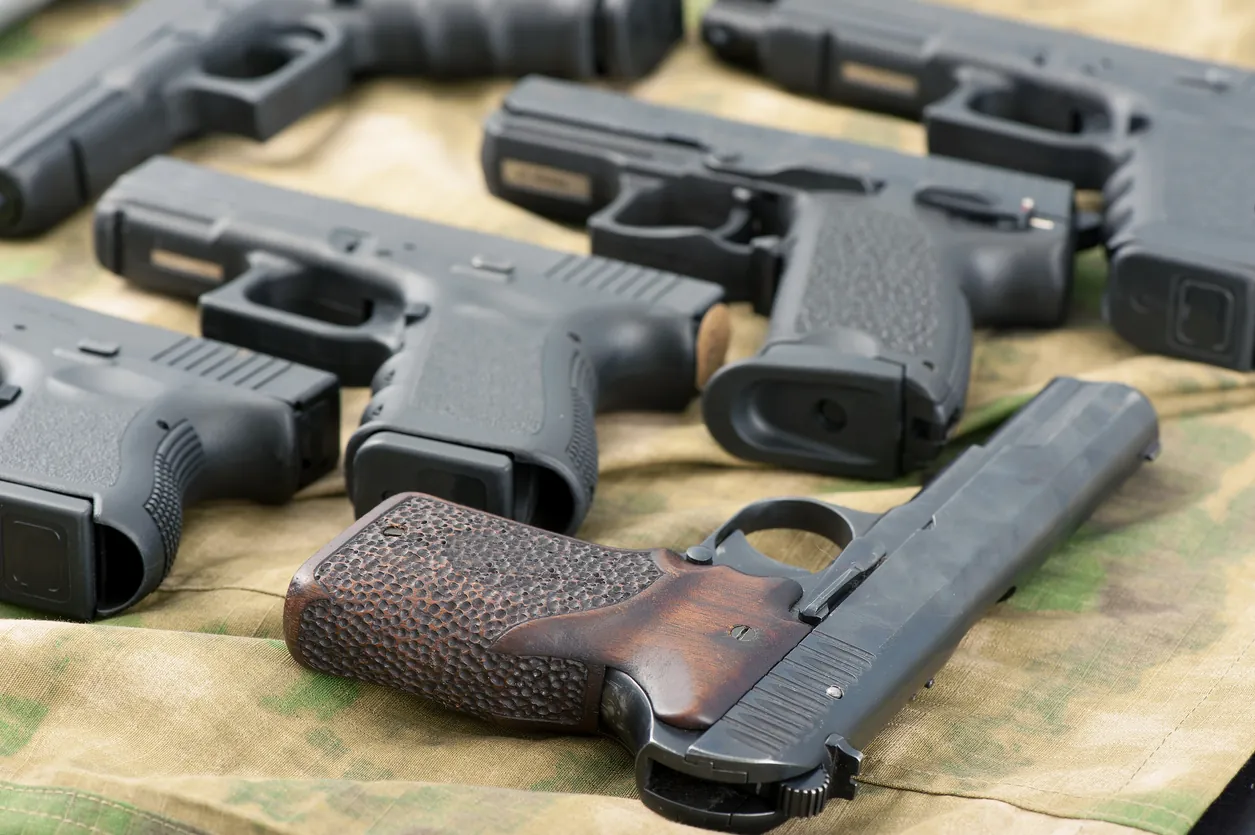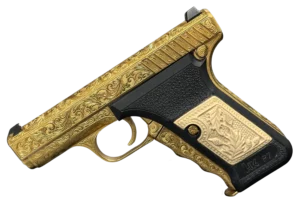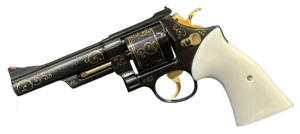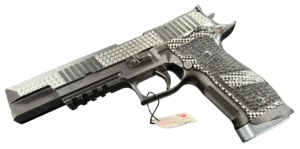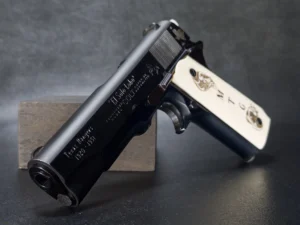Key Takeaways:
- Firearm Collecting Is About Legacy, Not Just Ownership: Firearms aren’t just objects—they’re historical touchstones, personal heirlooms, and cultural artifacts. Collectors value them for the stories they tell, the craftsmanship they display, and the connections they create across generations. Passing them down means passing on knowledge, tradition, and personal history.
- Preservation and Presentation Go Hand in Hand: Maintaining a firearm’s condition involves more than just cleaning and oiling—it’s about smart storage, environmental control, careful restoration, and detailed documentation. But it doesn’t stop there. How you display your collection matters too, blending aesthetics with security to showcase your firearms as both art and heritage.
- Community, Compliance, and Connection Matter: Collectors thrive when they engage—whether at gun shows, in clubs, or online. But with that connection comes responsibility. Knowing the legal requirements, storing firearms safely, and ensuring your investments are made safely and responsibly ensures that collecting remains a safe, respectful, and sustainable pursuit.
Collecting firearms is a journey through history and craftsmanship. Each piece tells a story of innovation and tradition.
For many, it’s more than a hobby; it’s a passion. The allure of antique firearms and vintage guns captivates enthusiasts worldwide.
These collectors cherish the intricate designs and historical significance of each firearm. They seek to preserve and showcase their collections with pride.
Proper preservation is crucial to maintaining the value and condition of collectible firearms. It requires knowledge and dedication.
Displaying a firearm collection is an art form in itself. It involves balancing aesthetics with security and safety.
Gun shows and online forums offer opportunities to connect with fellow enthusiasts. They provide a platform to share knowledge and expand collections.
Understanding the legal aspects of gun ownership is essential for responsible collecting. It ensures compliance and peace of mind.
This guide will explore the intricacies of preserving and displaying your firearm collection. It aims to educate and inspire collectors at all levels.
The Allure of Collecting Firearms: History, Passion, and Community
Collecting firearms offers a unique connection to history. Each firearm is a tangible link to the past. These artifacts transport collectors to different eras and events.
The passion for firearms often begins with the allure of antique designs. Their craftsmanship and functionality inspire admiration. Many enthusiasts are drawn to the detailed engineering of these vintage guns.
For collectors, firearms represent more than just objects. They embody stories and legacies. Each piece in a collection has a history that contributes to its mystique.
A sense of community surrounds firearm collecting. Enthusiasts gather at gun shows and join clubs to share their interests. These gatherings foster friendships and provide valuable networking opportunities.
The appeal of collecting firearms extends beyond the individual. Families often pass down collections as treasured heirlooms. This act preserves the legacy and personal history tied to each firearm.
Firearm collecting encompasses a wide range of interests. Each collector may focus on specific types or eras, such as:
- Antique firearms: Pre-20th-century designs with historical significance.
- Military firearms: Weapons with a rich service history.
- Collectible firearms: Rare or limited-edition models from famous manufacturers.
As collectors build their firearm collection, they become part of a larger tradition. This tradition celebrates both the technical marvels and the cultural significance of firearms.
Understanding Firearm Types: Antique, Vintage, and Collectible
Firearm collecting begins with understanding different types. Each category has unique characteristics and historical contexts. Knowing these helps guide any collector’s journey.
Antique firearms captivate with their history and craftsmanship. Typically, they date before the 20th century. These guns were built by hand, showcasing exceptional skill.
Vintage guns are a step closer to modern times. They usually come from the early to mid-20th century. These firearms reflect advancements in technology and design.
Collectible firearms vary greatly but share one key trait. They are sought after for their rarity, beauty, or manufacturing excellence. These often include special editions or models with limited production runs.
Understanding these distinctions is crucial for building a meaningful collection. It helps enthusiasts assess an item’s value and historical significance. Additionally, it aids in making informed purchasing decisions at auctions or gun shows.
Here is a simple breakdown of each type:
- Antique Firearms: Pre-1900, hand-crafted, historical significance.
- Vintage Guns: Early 20th-century, mass-produced, technological evolution.
- Collectible Firearms: Rare, limited editions, prized for craftsmanship or provenance.
Knowing these types enriches the collecting experience. It deepens appreciation for each piece’s place in history. Furthermore, this knowledge enhances the ability to engage and share with other enthusiasts.
Building Your Collection: Sourcing, Authenticity, and Provenance
Building a firearm collection requires both patience and diligence. Sourcing quality pieces is the first step. Antique firearms can be found at auctions, estate sales, and specialized gun shows.
Each source offers different advantages. Auctions may provide rare items but usually come with competition. Estate sales can be hidden gems offering unappreciated treasures at reasonable prices.
Authenticity is crucial for any serious collector. Verifying an item’s legitimacy ensures its value and integrity. Many collectors rely on expert evaluations or detailed documentation to confirm authenticity.
Provenance plays a pivotal role in any collection. It refers to the documented history of a firearm. This history can enhance an item’s value and appeal significantly.
Provenance might include previous owners, historical usage, or involvement in significant events. For example, firearms linked to famous figures or battles may attract significant attention.
Building a reputable collection involves diverse strategies:
- Sourcing: Explore various avenues like auctions and estate sales.
- Authenticity: Seek expert evaluations and trustworthy documentation.
- Provenance: Research the firearm’s history for added value.
Connecting with other collectors can also provide insights into sourcing and authenticity. Peer recommendations and shared experiences are invaluable in this hobby. Engaging with local clubs or online forums fosters a network of knowledgeable enthusiasts willing to offer guidance.
In essence, building a collection of firearms is about more than acquiring items. It involves cultivating knowledge and expertise. By understanding sourcing, authenticity, and provenance, collectors ensure their collection is both valuable and historically significant. This comprehensive approach enriches the collecting experience, transforming it into a journey filled with history and discovery.
Legal Considerations and Responsible Gun Ownership
Understanding legal requirements is essential for firearm collectors. Gun ownership comes with significant responsibilities. Laws can vary greatly depending on your location.
Each country, and often regions within countries, has unique regulations. These rules can affect what you own and how you store it. It’s crucial to familiarize yourself with local laws to ensure compliance.
Proper gun storage is a key aspect of responsible ownership. Storage regulations often emphasize safety to prevent unauthorized access or accidents. This might include the use of locked safes or secure rooms.
Being informed extends beyond local laws. Collectors should also be aware of international regulations. These can impact the acquisition and transportation of firearms across borders. A comprehensive understanding helps avoid legal pitfalls.
Key responsibilities for gun owners include:
- Compliance: Stay updated on all relevant laws and regulations.
- Storage: Implement secure storage solutions to prevent unauthorized access.
- Documentation: Maintain thorough records of ownership and transactions.
Additionally, ethical considerations play a crucial role in firearms collecting. Collectors should respect historical and cultural sensitivities related to their pieces. This mindful approach further underscores responsible ownership and fosters a respectful, informed community.
In summary, knowledge of laws and responsible practices enhances the overall collecting experience. It ensures collectors respect both their firearms and the broader community. By doing so, gun ownership becomes a safer and more rewarding endeavor.
Preserving Your Firearms: Cleaning, Maintenance, and Restoration
Preservation is critical in firearm collecting. Regular cleaning and maintenance keep your pieces in prime condition. Failing to maintain upkeep can lead to deterioration, which affects both value and functionality.
Proper cleaning involves using the right tools and solutions. Always select products specifically designed for firearms to prevent damage. These tools typically include soft cloths, brushes, and specialized solvents.
Routine maintenance extends beyond cleaning. Lubrication is essential to ensure smooth mechanical operation. However, apply lubricants sparingly to avoid attracting dust and grime.
Restoration can breathe new life into vintage guns. However, it requires a cautious approach. Restoring can enhance the appearance but may alter the original features. It’s crucial to weigh the benefits against potential impacts on authenticity.
Consider these steps for practical firearm preservation:
- Regular Cleaning: Use appropriate tools and cleaners for each firearm.
- Lubrication: Apply quality lubricants after cleaning to ensure smooth operation.
- Protection: Keep firearms dry and in a controlled environment to prevent rust.
- Consideration: Weigh restoration options carefully, respecting historical integrity.
If contemplating restoration, consult experts. Professionals can provide guidance and avoid irreversible mistakes. Finding the balance between preservation and originality is an art in itself.
Ultimately, diligent care enhances both the enjoyment and longevity of your collection. Each firearm tells a story, and preserving it means safeguarding that narrative for future generations. Thus, proper maintenance becomes an integral part of the collecting experience.
Storage Solutions: Security, Safety, and Environmental Control
Proper storage is crucial for preserving firearms, striking a balance between security, safety, and environmental control. Each aspect plays a vital role in maintaining the integrity and value of your collection.
Security begins with a reliable storage solution. Gun safes are a popular choice among collectors, offering protection against theft and unauthorized access. When selecting a safe, consider size, locking mechanisms, and fire ratings.
Safety involves proper handling and placement of firearms. A safe should prevent accidental access, particularly where children are present. Additionally, ensure firearms are unloaded before storage to mitigate risk.
Environmental control is essential to prevent deterioration. Fluctuations in temperature and humidity can cause damage to your firearms. Using a dehumidifier inside your safe helps maintain optimal conditions.
Consider these storage solutions for your collection:
- Gun Safes: Choose a safe that meets your security and size needs.
- Dehumidifiers: Control moisture levels to prevent rust and other types of damage.
- Rack Systems: Organize firearms for easy access and prevention of scratches.
- Soft Cases: Offer extra protection when transporting firearms.
When storing firearms, be aware of nearby materials that could potentially affect them. Avoid fabrics that can hold moisture and chemicals that may corrode metals. Always keep firearms out of direct sunlight, as it can cause fading of finishes over time.
Ultimately, storage is about more than just containment. It’s about providing a haven that preserves the aesthetic and mechanical excellence of each firearm. By implementing these storage solutions, you can ensure that your collection remains a reliable reflection of history and craftsmanship. Taking the time to establish proper storage conditions today pays dividends in preserving the legacy of your collection for the future.
Displaying Your Collection: Showcasing with Style and Security
Displaying your firearm collection is an art that combines aesthetics with safety. Exhibiting your prized pieces allows for admiration while maintaining strict security protocols.
Begin by assessing the display area. Choose a location that offers both visibility and limited access. Consider areas that enable you to balance beauty with protection.
Display cases provide a professional solution. Opt for cases with glass fronts, allowing viewers to appreciate details while keeping firearms secured. Lockable cases are essential to prevent unauthorized handling.
Lighting is crucial in showcasing your collection. Use soft, focused lighting to highlight key aspects of each firearm, bringing out the craftsmanship without causing glare. LED lights are a popular choice due to their low heat output and energy efficiency.
Create a visual narrative through strategic arrangement. Group firearms by type, era, or manufacturer to guide viewers through a coherent story. This not only enhances appreciation but also aids in remembering the details of each piece.
Here are some tips for effective firearm displays:
- Secure Displays: Use cases with locks and durable materials.
- Proper Lighting: Highlight details while avoiding direct glare.
- Thematic Arrangements: Organize firearms to tell a story.
- Non-Reflective Backgrounds: Reduce distraction with simple, dark backdrops.
- Labeling: Provide informative plaques for context and historical details.
Consider the safety of materials used in your display. Ensure that supports and mounts do not scratch or damage the firearms. Use padding or soft materials for contact points to protect delicate finishes.
Security in displaying firearms is non-negotiable. Use additional locking mechanisms on display cases, and consider integrating security systems with motion detectors and cameras to safeguard your collection against theft.
Incorporating both style and security, your display becomes more than a storage solution; it transforms into a curated exhibit of history and craftsmanship. Tailoring each element to fit your collection’s needs not only enhances visual impact but also protects your valuable assets. By paying attention to these factors, you can create a stunning and secure environment where your firearms collection is celebrated and preserved.
Documentation and Cataloging: Keeping Track of Your Collection
Thorough documentation is fundamental to managing a firearm collection. Accurate records increase both the historical value and personal satisfaction derived from your collection.
Begin by creating an inventory. Document each firearm with details such as the make, model, serial number, and condition. Photos complement records, capturing both the overall piece and intricate details.
Digital tools can simplify this process. Consider using apps or spreadsheets to organize data, offering easy access and updates. This ensures that your collection’s information is readily available and protected from physical loss.
In addition to basic records, consider adding a deeper narrative. Include provenance documents that trace the firearm’s history, including past ownership and any modifications. This enriches the story of your collection and can add significant value.
Here are some elements to include in your catalog:
- Basic Information: Make, model, caliber, and serial number.
- Condition Notes: Details on wear, restoration, and current condition.
- Photographic Evidence: Images capturing the firearm’s unique features.
- Historical Context: Documentation of provenance and historical relevance.
- Appraisal Values: Insurance and market valuations for each piece.
Keep backups of your records, both digitally and in physical form. Secure digital copies on external drives or cloud services to prevent data loss. Printed copies stored separately ensure redundancy in cases of technological failure.
Adequate documentation does more than organize; it transforms your collection into a well-crafted narrative, preserving its history and integrity for future generations. By maintaining detailed records, you safeguard your investments and enrich your understanding of each piece’s role in history.
Insuring and Protecting Your Investment
Safeguarding your firearm collection involves more than just physical protection. Insurance plays a vital role in ensuring your investment is secure against unforeseen events.
Start by assessing your insurance needs. Review the total value of your collection to determine the coverage required. Consult with insurers specializing in firearm policies, as they understand the unique needs of collectors.
When insuring, provide detailed documentation. Accurate appraisals and comprehensive records support your insurance claims. These documents demonstrate the value of your collection and facilitate smoother claim processes.
Consider the following factors when insuring your collection:
- Coverage Type: Decide between a blanket policy or scheduled coverage for individual pieces.
- Appraisal Requirements: Some insurers may require updated appraisals for coverage.
- Policy Limits: Ensure the policy covers potential complete loss, not just partial values.
- Security Measures: Confirm that in-home security systems and safes meet insurance standards.
Regularly revisit your policy to reflect changes in your collection. As you acquire new pieces or values shift, update your coverage accordingly. This practice ensures that your collection remains adequately protected over time.
Proactively insuring your firearms demonstrates responsible gun ownership. It not only protects your financial investment but also preserves the historical and personal stories embodied in each piece. This approach highlights the dedication required to build a thoughtful and well-maintained collection.
Engaging with the Community: Gun Shows, Clubs, and Online Forums
Building a firearm collection benefits significantly from community engagement. Connecting with fellow enthusiasts can enhance your knowledge and enjoyment. Gun shows are excellent venues for meeting like-minded collectors. These events provide opportunities to view rare pieces and interact with experts. The unique atmosphere of a gun show fosters a shared passion and learning experience.
Joining local or national firearm clubs can deepen your involvement. Clubs often offer workshops, lectures, and access to exclusive events. Engaging with a club allows you to discuss trends, share insights, and gain new perspectives on your collection endeavors.
Online forums and social media groups expand your reach even further. These platforms provide real-time advice and networking opportunities. They are invaluable for learning about market trends and new opportunities. Engaging online supports continuous education and connection across geographic boundaries.
Consider participating in:
- Gun Shows: Discover new pieces and market trends.
- Firearm Clubs: Gain access to resources and exclusive events.
- Online Forums: Tap into global communities for real-time insights.
By participating in these communities, you enrich your collecting experience. The shared knowledge and camaraderie you find enhance both your skills and your appreciation for the world of firearms. Engaging with others ensures that your passion continues to thrive and evolve.
Passing Down the Legacy: Education, Heirlooms, and Storytelling
Collecting firearms is not just a hobby; it’s a legacy. Passing your collection down to future generations can preserve history and shared traditions. This generational transfer of passion involves careful planning and storytelling. Your firearm collection tells stories of craftsmanship, historical events, and personal journeys.
Education plays a vital role in this legacy. Teaching younger family members or enthusiasts about the significance of each piece fosters appreciation. Explain the historical context and technical details to keep stories alive. Hands-on education, such as safe handling and maintenance, enhances the learning experience.
Family heirlooms often hold a unique place in firearm collections. These pieces carry not only their history but also personal family narratives. Sharing the stories behind heirloom firearms adds a layer of emotional connection.
Consider the following to pass down your collection effectively:
- Education: Share the history and significance of each piece.
- Heirlooms: Highlight firearms with familial importance.
- Storytelling: Use anecdotes to bring the past to life.
The act of storytelling enriches the experience of collecting. By passing down your knowledge and stories, you ensure your collection’s legacy endures. Connecting history with future generations preserves both personal and cultural heritage in meaningful ways.
Conclusion: The Enduring Value of Firearms Collecting
Firearms collecting is a pursuit that merges passion, history, and craftsmanship. Each piece in a collection reflects unique stories and technical evolution across time. The allure lies not only in the tangible ownership but also in the intangible wealth of knowledge and stories collected along the way.
Maintaining and displaying a collection requires dedication and commitment. Proper preservation ensures longevity, while thoughtful display methods enhance appreciation and understanding. This blend of responsibility and creativity adds depth to the collecting experience, transforming it into an enriching journey.
As collectors pass their treasures on, they preserve a legacy. This act of sharing knowledge, history, and passion secures the future of firearm collecting. It fosters a sense of belonging within the broader community, connecting enthusiasts across generations through a shared love for firearms and their stories.
Frequently Asked Questions
Start by figuring out what interests you most—antique military pieces, vintage sporting guns, or rare limited editions. From there, conduct your research, connect with other collectors (through forums, shows, and clubs), and prioritize learning about authenticity, condition, and provenance before making any purchases.
Generally, antique firearms are made before 1900, often handcrafted. Vintage guns, dating from the early to mid-20th century, reflect the evolving technology of the time. Collectibles can be from any era but are sought after for rarity, special editions, or unique provenance.
A high-quality gun safe is a must; look for one with fire protection, secure locks, and sufficient space for future acquisitions. Use dehumidifiers to prevent rust, and avoid direct sunlight or damp environments. For extra security, consider installing alarm or camera systems.
Yes. Even unfired firearms can develop rust or corrosion over time, especially in humid climates. Regular cleaning and lubrication every few months, combined with routine visual inspections, help maintain both the function and appearance.
It depends. Light cleaning or stabilizing rust is usually acceptable, but heavy restoration (such as refinishing or replacing original parts) can lower the value if it alters the gun’s originality. When in doubt, consult a professional who specializes in antique or collectible firearms.


